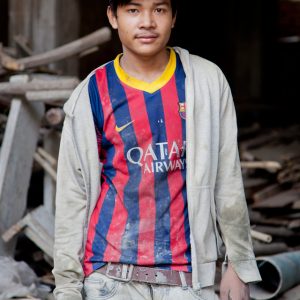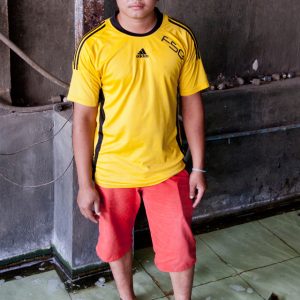When a stray bullet missed Yim Sithay’s head by a matter of inches, her commitment to the cause was galvanised. “The [security forces] began shooting, so we all ran,” she remembered. “Many people were scared and stopped protesting afterwards. But I knew it was important to continue.”
It was January 2014, and as 31-year-old Yim marched alongside hundreds of fellow garment workers down a dusty road in Phnom Penh to call for a raise in the minimum wage, military police opened fire. Five people were killed.
The Garment Manufacturers Association in Cambodia (GMAC), an organisation that represents factory owners, described these deaths as “collateral damage”, local media reported.

But for Yim the deaths were yet another example of an attack on the poor. “The rich do what they want and say it’s good for Cambodia. They shoot at us for protesting and say it’s good for Cambodia. They evict us from our houses and say it’s good for Phnom Penh,” she said. “The rich do not like us poor – the workers. But I think we are strong.”
Cambodian society has experienced significant societal shifts during the past two decades. Increasing rates of urbanisation and a rapidly growing economy have transformed the Kingdom, which is poised to become a lower-middle-income country within the next two decades, according to the IMF. In the midst of these changes, much attention has been lavished on the emerging middle class.
“Of course we have an urban middle class [in Cambodia], and these people are the success story that neo-liberal pundits would constantly want to remind us of,” said Simon Springer, assistant professor at the University of Victoria, Canada. But what has been overlooked, he added, is the emergence of an urban working class.
This has been a relatively recent development, Springer explained, which came about due to coinciding events. Since the 1990s, Cambodia has experienced a decline in subsistence farming due in part to wealthy companies taking over land in rural areas and the eviction of farmers from their plots.
At the same time, the urban economy has boomed, largely due to increasing industrialisation. As new factories, construction sites, shops and the service industry grew in urban areas, the jobs these industries offered were often taken by the rising number of rural migrants.
The UN Capital Development Fund estimates that in 1990 half of the country’s GDP was generated by agriculture – by 2012 this had fallen to about 20%. During the same period, statistics from the World Bank show that urban areas went from producing 20% of the country’s GDP to almost 60%.
Mu Sochua, MP for Battambang and a prominent member of the opposition Cambodia National Rescue Party (CNRP), has witnessed this change in her country’s society. “For sure there is a working class,” she said, adding that they are often the children of farmers, attracted to urban areas by new employment opportunities and the higher incomes they offer. “Take the garment workers, almost 80% are migrants from the countryside.”

While it is generally agreed how the working class developed in Cambodia, there are differing ideas about who constitutes this group.
According to Sochua, they are construction workers, rubbish collectors, cleaners, entertainment and garment workers – generally, those in ‘unskilled’ jobs. She estimates that there are almost 600,000 garment workers and more than a million people employed in the other occupations.
Dave Welsh, Cambodian country director for labour rights group Solidarity Centre, contends that civil servants, teachers and workers in the service and tourism industries could also be considered working class because of their low wages. “Like garment or construction workers, they’re not even earning a living wage,” he said.
Such disagreements are not exclusive to Cambodia. Across the world, for at least two centuries, there has been no agreed definition of what constitutes a working class. For Marxists, the working class are those who sell their labour for wages and do not own the means of production – such as land, factories or shops – and work for those that do. For others, the working class is defined by occupation or by income.
“The working class [in Cambodia] is ill-defined,” said Springer, “[because] the boundaries are fluid and continuously changing. But that doesn’t undermine the legitimacy of the idea, it simply suggests that there’s an evolving understanding. The form of labour is arguably the most obvious identifier, but not to be overlooked are identity politics and the sense of belonging.”
In south Phnom Penh, a few hundred metres from where military police opened fire on Yim and the other garment workers last January, a row of poorly built rooms house a growing number of garment workers.
Samey, 20, has been working in a factory for the past year since migrating to Phnom Penh from nearby Prey Veng province which, despite its proximity to the capital, is a world away in terms of development and opportunity. In her small one-room apartment, she smiles nervously when asked about her position in society.
“I have been to Diamond Island [a new residential and leisure development] and it’s very different; it’s very clean and people look happy,” she said. “But here, we do not have much. The roads are bad, and I have been ill for many months.”
Her next-door neighbour, Pan, 31, also notices differences in society. “In Prey Veng, where I come from, peoples’ lives are not different. But here [in Phnom Penh], there are poor people, like us, and rich people. We do not get the same things.”
“If you look at class consciousness, it’s present in particular ways,” explained Springer. “People are aware of their socio-economic status… The elite know they are the elite and the poor are similarly aware of their marginalisation and their lack of access to power.”
![Sem Poutek, 31, garment worker. For the past three years, Poutek has been cutting cloth in one of Phnom Penh’s many garment factories, a job he wanted in order to earn a regular monthly salary. “I was aware of the strikes [last year], but I couldn’t participate because I was too scared I’d lose my job,” he said. Although he does not want to stay in the city for the rest of his life, he admitted that it might be difficult to return to his village because there is little work. Photo: Francis Wilmer for SEA Globe](https://southeastasiaglobe.com/wp-content/uploads/2015/04/WorkingClass-15-300x300.jpg)
In his 1923 work, History and Class Consciousness, the Marxist philosopher György Lukács wrote that to understand one’s position in society is the first step in developing class consciousness – for it to mature, however, it is essential that a class understands its position in politics.
One criticism levelled against the theory of a working class in Cambodia is that they are not politically engaged. While it may or may not be indicative of wider trends, a handful of garment workers interviewed by Southeast Asia Globe claimed a lack of participation when asked about politics.
Pan knew about the ruling Cambodian People’s Party (CPP) and the CNRP, but could not allude to anything beyond their names. “When I started as a worker, I wanted to join a union, but I am too scared. People were shot, and maybe I lose my job if I join,” she said.
Only one of six garment workers interviewed had voted in general elections. “No political parties come to this area,” said Sem, 42. “I have voted – I went with my gut.”
However, Welsh said that the political importance of Cambodia’s workers is growing – there is a burgeoning labour movement and the two main political parties are making strides to “woo” the workers as voters – with 80% of garment workers unionised. He believes their willingness to protest and their success in increasing the minimum wage serves as an inspiration.
“In terms of workers being able to apply political pressure, the garment workers take the lead in that. They are the working-class aristocracy,” Welsh said. “There is no better evidence of this than [the weeklong garment worker strike in] January last year. The strike shut down the country’s most important sector and for eight days created chaos.”
In the months that followed the strikes, significant numbers of teachers, rubbish collectors and construction workers also staged walkouts, demanding increases to their own minimum wage levels.
The garment workers also hold much economic sway. According to the Solidarity Centre, the garment industry produces 80% of Cambodia’s exports and the workers’ labour generates $5 billion annually for the economy. GMAC estimates that the January strikes cost the industry almost $200m, while the losses accrued by other strikes over the past three years remains unknown.
Similarly, the economic importance of construction workers cannot be overlooked. In 2013, the Ministry of Land Management, Urban Planning and Construction approved 1,641 new construction projects, with a total value of $2.8 billion, government statistics show. Industrial action in this sector would have the potential to cause considerable losses.
Such strength has resulted in both the CPP and the CNRP clamouring to attract workers as voters.
“The movement for change, of which the urban workers were an essential element, was totally inspiring and took us all by surprise,” said Sochua, referring to the closely contested 2013 national election.
According to Sochua, the Sam Rainsy Party – which in 2012 merged with the Human Rights Party to form the CNRP – sprung from the labour movement. “We are the party of the working class,” she said. “The workers died for us. They were killed for the cause, their cause.”
Of course, the ruling CPP has its own, equally fervent, take on the situation. “We don’t buy the workers like the CNRP. They trick the workers by saying they will raise their salaries to high levels, but this is not possible,” said Council of Ministers spokesman Phay Siphan. “We try to improve the wellbeing of the workers by bringing them into economic development. They are important politically, and we want to help them to go from unskilled to skilled and to give them more money and more spending power. Economic growth, which we are leading, is the only way their lives will improve.”
In his influential book The Making of the English Working Class, E.P. Thompson wrote that the formative years of the English working class lasted for about half a century, from 1780 to 1832. In Cambodia it has only been a decade or so in the making, and the steamroller of progress means that urbanisation and industrialisation will only continue, cementing the position of the country’s urban workers.
“I’m proud to be a garment worker,” said Yim. “I think us workers, us poor, are important – we make the country rich. Our place in Cambodia is essential.”
Q&A with Markus Karbaum

The question of whether a working class exists in Cambodia has rarely been asked, and there are those who doubt its existence. Markus Karbaum, an independent consultant specialising in Cambodian politics, presents a view from one side of the divide
Are urbanisation and capitalism altering Cambodian society?
Yes, they are. Compared to rural life during the last centuries, access to information has increased extensively. In addition, geographic mobility takes people beyond their villages, communes and districts. We are just witnessing the beginning of a dramatic change in the Cambodian way of life, but I do not know where it will end.
Are garment workers and other workers important politically?
Most of them are busy with mundane issues and only very few workers are politically engaged. At the moment, the government benefits from this political apathy. For the CNRP, it is not that easy to mobilise workers for its own political goals.
Do you think Cambodians are conscious of their differences socially and economically?
There is rather a hierarchical awareness: The rich and powerful on the top of the ladder, the poor and marginalised at the bottom. Hence, peasant farmers and garment workers still have more similarities than differences. Maybe in the future there will be a gap between these groups, deepening the urban-rural antagonism.
Does Cambodia have a working class?
No, I don’t think so. I don’t think there are the necessary conditions to bring about an evolution of a working class, such as a homogenous group of people creating a milieu with a typical self-awareness, attitudes and behaviour.


